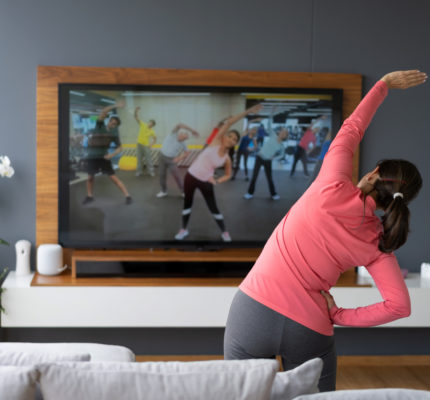According to the latest data published by the Centers for Disease Control and Prevention, there are approximately 160.5 million female residents in the United States. For those women who are over 18, more than 13.5% are in fair or poor health; less than half meet the federal daily exercise requirements. And 36.4% of women 20 and older fall into the obese BMI category.[1. Center for Disease Control and Prevention, “Women’s Health: FastStats,” http://www.cdc.gov/nchs/fastats/womens-health.htm]
It’s time we all take better care of ourselves.
Beginning with Mother’s Day on Sunday, May 10, this week marks the 16th annual National Women’s Health Week, according to the U.S. Department of Health and Human Services Office on Women’s Health. This is a great time for employee and health plan wellness coordinators to remind women how important it is to put their well-being front and center. If you’re a client of WebMD Health Services, this is easy: Just log in to the Client Community now in order to download our beautifully designed Women’s Health awareness campaign to share with your population!
In honor of National Women’s Health Week, here are five tips on how to jump start making your health a priority each and every day. (Men: Stay tuned for National Men’s Health Week next month!)
1. Go for Your Annual Women’s Wellness Exam. Because of the Affordable Care Act, more women across America who use an in-network provider now have access to female-targeted preventive services without the hassle of a co-pay or co-insurance. There’s no good reason not to take advantage! As part of your well-woman checkup (which is now considered separate from any other physical exam or injury-related visit) you’ll be able to track your health history and set realistic weight-loss or exercise goals for the future. Plus you’ll have access to:
- a Pap test every 2-3 years if you’re over 21 (women between 30 and 64 can get a Pap test and human papillomavirus (HPV) test together every 5 years instead)[2. WomensHealth.gov, http://www.womenshealth.gov/publications/our-publications/fact-sheet/pap-test.html] to detect early signs of cervical cancer
- a mammogram every 1-2 years for women over 40 to detect early signs of breast cancer
- HIV and other STI screening and counseling
- birth control counseling services
- osteoporosis screening and counseling for women over 65
2. Get Regular Physicals. Do you operate at your optimum capacity each and every day? Or are you suffering from a physical ailment that just won’t go away? Preventive care is the first step to making sure you’re keeping track of your vitals and staying on top of your health. If you have an ongoing issue, a regular physical can help pinpoint the problem and nip it in the bud before it gets any worse. And by screening for high-risk conditions like high blood pressure, elevated cholesterol levels, or skin cancer, you’ll be better prepared to catch warning signs early and can adopt an age-appropriate treatment plan if one should be necessary. You know what they say, “an ounce of prevention is worth a pound of cure.” Thanks Benjamin Franklin.
3. Exercise. Taking part in some regular form of physical activity not only keeps your bones strong and your body in shape, but it also helps clear the mind of built-up stress. According to the Office of Disease Prevention and Health Promotion’s most recent Physical Activity Guidelines for Americans (2008), adults should do at least 2.5 hours of moderate-intensity exercise, 75 minutes of vigorous-intensity aerobic physical activity, or an equivalent combination the two, every week.[3. Office of Disease Prevention and Health Promotion, U.S. Department of Health and Human Services, “2008 Physical Activity Guidelines for Americans Summary,” http://www.health.gov/paguidelines/guidelines/summary.aspx] And remember, you don’t have to push yourself to the limit to feel tip-top. Running laps twice a week, speed walking around the neighborhood every other day, or getting hooked on Zumba class with your best pal are all super ideas to get momentum on your fitness routine. The best part is you’ll start feeling good about your progress in a matter of days!
4. Manage Stress Effectively. According to this well-cited infographic posted on the American Institute of Stress’s website, 44% of Americans feel more stressed than they did 5 years ago, 1 in 5 Americans experience “extreme stress” (shaking, heart palpitations, depression), and 3 out of 4 doctor visits are for stress-related ailments such as heart disease, heart attack, and stroke. A whopping 60% of all human illness and disease is caused by stress or complications from stress![4. The American Institute of Stress, “Stress Is Killing You,” http://www.stress.org/stress-is-killing-you/] With statistics like these, it’s important to be aware of your stress levels—and to take action when life feels too out of control, like making use of counseling services both in and outside the workplace, getting adequate sleep each night, and not relying on bad habits like smoking to keep stress at bay.
5. Eat a Balanced Diet. Paying attention to the foods you eat each day should be a no-brainer. But with all the conflicting studies published on what’s healthy and what should be avoided, it can often be difficult to figure out a dietary plan that’s right for you. To prevent heart disease, stroke, and other deadly illnesses, a general rule is to eat plenty of nutrient- and vitamin-rich fruits and vegetables (especially leafy greens!); protein-heavy foods like fish, lean red meat, beans, eggs, and nuts; low- or no-fat dairy products (yogurt is a great source of calcium), and whole grains such as rice or oatmeal. Foods containing trans fats, added sugars, or high amounts of sodium should be avoided. And for those of you who drink alcoholic beverages, moderation is key! That means for women, one drink—12-fluid ounces of beer, 5-fluid ounces of wine, or 1.5 ounces of 80-proof distilled spirits—per day.[5. Office on Women’s Health, U.S. Department of Health and Human Services, “How to Eat for Health,” http://womenshealth.gov/fitness-nutrition/how-to-eat-for-health/] For more detailed information, check with your health care provider. Or check out these helpful resources:
- WebMD’s Healthy Eating Guide
- USDA’s Choose My Plate for creating your own personalized healthy diet
- US FDA’s Guide to Understanding Nutritional Labels






